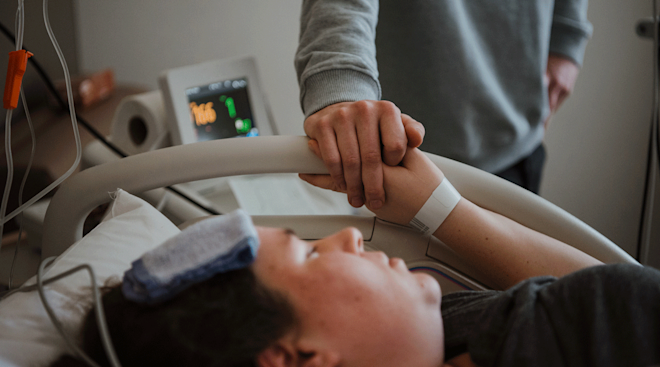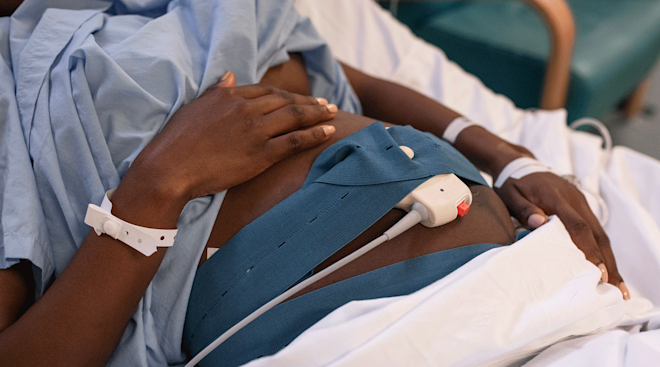When to Go to the Hospital for Labor
The late stages of pregnancy can be a nail-biting experience. You’re so eager to meet your little one that every tiny pinch might feel like a contraction. And, of course, a pressing question keeps coming up: When should I go to the hospital for labor?
Labor is different for everyone and babies are unpredictable, which can lead to a lot of confusion around when to grab your hospital bag and go. Ahead, experts break down what you should know about when to go to the hospital for labor.
First, keep in mind that just because you’re in labor doesn’t mean you need to go to the hospital right away. During early labor, which often lasts about six to 12 hours for first-time moms, you may feel mild contractions that come every five to 15 minutes and last 60 to 90 seconds, according to March of Dimes. You may also experience the bloody show: pink, red or bloody vaginal discharge. During this stage, you can stay home and relax—for now. When your contractions become stronger, longer and more painful, you’re ready to head to the hospital. (More on this soon!)
The signs of labor can vary from person to person. “Labor requires the cervix—opening to the uterus—to soften, dilate and thin for the fetal head to progress through the pelvis,” says Lisa Thiel, DO, maternal-fetal medicine specialist at Corewell Health. “For some women, this involves painful, frequent contractions and for [others], they may not feel much discomfort until rather far along in the process. It’s not often that the water breaks with heavy contractions as we see in the movies.”
I was induced with my first child and when I had my second, there was a lot I still didn’t know about the early labor process. So, when I had consistent contractions that came every five minutes and lasted for a minute each, my husband and I headed to the hospital—just as we’d been advised.
But we were sent home an hour later with this advice from my ob-gyn: “You’ll know when you’re in labor.” She was right. I woke up in the middle of the night with contractions that took my breath away. We headed back to the hospital and my son was born a few hours later.
I’m not the only one who was confused by her contractions. Ashley A., a mom of one in Massachusetts, says she started feeling contractions with her daughter on a Monday, but didn’t actually give birth until Wednesday. “I spent the day at home watching TV, sitting on a yoga ball and timing my contractions,” she says. “I called my doctor a few times throughout the day on Tuesday, and they kept telling me to wait until my contractions got closer together. Finally, on late Tuesday night, the contractions were so painful—but still not close together—that the doctor said I could come in.”
Melissa J., a mom of three in Virginia, started having contractions on Christmas Eve but said they were “minor.” So she did her best to stay hydrated until her family decided it was time to take her to the hospital. “By the time we were on our way, I was in full-pain contractions,” she says. When Melissa arrived at the hospital, a doctor told her she wasn’t in labor. But then, he checked to see if she was dilated. “His eyes got very wide at that point and he said I have to go talk to someone,” Melissa says. A nurse came back and informed her that she was 5 centimeters dilated. Her baby boy was born later that day.
Contractions vs. false labor
True labor can be hard to tell apart from false labor pains, aka Braxton Hicks contractions. “Generally false labor pains, or Braxton Hicks, aren’t painful—it involves your uterus contracting, so you’ll see your belly get hard but it won’t hurt,” says Kamilah Dixon, MD, an ob-gyn at The Ohio State University Wexner Medical Center. “Contractions are painful. They can sometimes feel like period cramps or fullness in the pelvis, but generally start in the front lower pelvis and wrap to your back in a rhythmic fashion.”
So how do you know when to go to the hospital for labor? “We teach our moms the 5-1-1 rule on when to go to the hospital,” says G. Thomas Ruiz, MD, lead ob-gyn at MemorialCare Orange Coast Medical Center in Fountain Valley, California. “That’s when you have a contraction that’s painful, lasts a full minute and comes every five minutes for one hour.” If your water breaks, Ruiz says you should head to the hospital right away.
Ruiz adds that pain is an important factor. “The contraction can take your breath away,” he says. “If you’re having a real labor contraction, you really can’t talk—you have to breathe through it.”
But everyone is different, so it’s important to have the conversation on when to go to the hospital for labor with your healthcare provider in advance. For some patients, such as those with high-risk pregnancies or a previous C-section delivery, the 5-1-1 rule “may be too strict,” says Matthew Carroll, MD, assistant professor of obstetrics and gynecology at Baylor College of Medicine.
Dixon adds there may be other reasons to head to the hospital—for example, “if baby’s moving less than they normally do, as this can be a sign of labor or that baby’s experiencing stress, if you have vaginal bleeding and if you think your water broke.” As for when to call your doctor, Dixon says it depends on the practice. “You’re always free to call your doctor when you have a question, but I tell my patients if any of the above is happening, just head to the hospital so you don’t have to wait at home,” she says.
It depends. “Every hospital will have a different threshold to admit,” Carroll says. In general, if your cervix is dilating, that suggests you’re “entering active labor,” he says. Ruiz says his practice typically starts admitting patients once they’re 3 to 4 centimeters dilated.
“Also, if there’s concern about blood [pressure], evidence of rupture of membranes or concerns about well-being, those are additional reasons for admission,” Carroll says.
Exactly what happens at the hospital when you deliver can vary. But most follow a similar process: Usually, it starts with an assessment of your vitals and where you are in the labor process.
“The team will place a few soft straps around your abdomen with two small circular monitors to assess the heart rate and frequency of contractions,” Thiel says. Your healthcare provider will also take your blood pressure, heart rate and other vitals. “You may have an exam to assess the changes to your cervix as well,” she says. “If you’re contracting with some cervix changes, they may keep you on the monitor for an hour or two and reassess to see if your contractions are changing the dilation of the cervix.”
If it looks like you’re not far along in your labor, doctors may ask you to go home and wait it out for a bit. But if it seems like you’re getting close to being in active labor, Ruiz says they may recommend that you walk around for an hour to see if it helps you dilate further.
It can be hard to know exactly when to go to the hospital for labor. That’s why your healthcare provider is there to guide you through the process—so make sure to check in with them if you have any questions.
Please note: The Bump and the materials and information it contains are not intended to, and do not constitute, medical or other health advice or diagnosis and should not be used as such. You should always consult with a qualified physician or health professional about your specific circumstances.
Plus, more from The Bump:
Matthew Carroll, MD, is an assistant professor of obstetrics and gynecology at Baylor College of Medicine. He received his medical degree from Mount Sinai School of Medicine.
Kamilah Dixon, MD, is an ob-gyn and clinical associate professor of obstetrics and gynecology at The Ohio State University Wexner Medical Center. She received her medical degree from Georgetown University School of Medicine.
G. Thomas Ruiz, MD, is the lead ob-gyn at MemorialCare Orange Coast Medical Center in Fountain Valley, California. He received his medical degree from University of California Irvine School of Medicine.
Lisa Thiel, DO, FACOOG, is a maternal-fetal medicine specialist at Corewell Health. She received her medical degree from the Philadelphia College of Osteopathic Medicine.
March of Dimes, Stages of Labor, March 2019
Learn how we ensure the accuracy of our content through our editorial and medical review process.
Navigate forward to interact with the calendar and select a date. Press the question mark key to get the keyboard shortcuts for changing dates.




















































